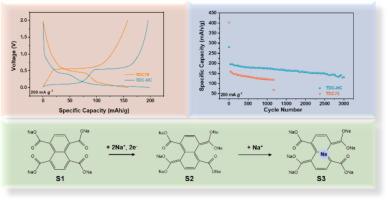用于钠离子电池的低氧化还原电位长寿命有机负极材料
IF 13.1
1区 化学
Q1 Energy
引用次数: 0
摘要
采用有机电极的钠离子电池(SIB)是一个新兴的研究方向,因为基于 C、H、O 和钠离子等元素的有机材料具有可持续性。目前,用于钠离子电池的有机电极材料主要用作阴极,因为它们的氧化还原电位相对较高(1 V)。而氧化还原电位较低且可用作阳极的有机电极却很少见。本文开发了一种新型有机阳极材料(1,4,5,8-萘四甲酸钠,Na4TDC),它具有较低的氧化还原电位(0.7 V)和出色的循环稳定性。通过各种原位/原位光谱和理论计算,证明了它的三钠储存机制,显示出 208 mAh/g 的高容量和每个循环仅 0.022% 的平均衰减率。此外,Na4TDC-硬碳复合材料还能进一步提高容量和循环稳定性,即使质量负载高达 20 mg cm-2,也能维持 1200 个循环。通过与厚Na3V2(PO4)3阴极(20.6 mg cm-2)配对,制备的全电池显示出高工作电压(2.8 V)、优异的速率性能和循环稳定性,200次循环后的容量保持率高达88.7%,充分彰显了Na4TDC阳极材料在SIB中的应用。本文章由计算机程序翻译,如有差异,请以英文原文为准。

A low redox potential and long life organic anode material for sodium-ion batteries
Sodium-ion batteries (SIBs) with organic electrodes are an emerging research direction due to the sustainability of organic materials based on elements like C, H, O, and sodium ions. Currently, organic electrode materials for SIBs are mainly used as cathodes because of their relatively high redox potentials (>1 V). Organic electrodes with low redox potential that can be used as anode are rare. Herein, a novel organic anode material (tetrasodium 1,4,5,8-naphthalenetetracarboxylate, Na4TDC) has been developed with low redox potential (<0.7 V) and excellent cyclic stability. Its three-sodium storage mechanism was demonstrated with various in-situ/ex-situ spectroscopy and theoretical calculations, showing a high capacity of 208 mAh/g and an average decay rate of merely 0.022% per cycle. Moreover, the Na4TDC-hard carbon composite can further acquire improved capacity and cycling stability for 1200 cycles even with a high mass loading of up to 20 mg cm−2. By pairing with a thick Na3V2(PO4)3 cathode (20.6 mg cm−2), the as-fabricated full cell exhibited high operating voltage (2.8 V), excellent rate performance and cycling stability with a high capacity retention of 88.7% after 200 cycles, well highlighting the Na4TDC anode material for SIBs.
求助全文
通过发布文献求助,成功后即可免费获取论文全文。
去求助
来源期刊

Journal of Energy Chemistry
CHEMISTRY, APPLIED-CHEMISTRY, PHYSICAL
CiteScore
19.10
自引率
8.40%
发文量
3631
审稿时长
15 days
期刊介绍:
The Journal of Energy Chemistry, the official publication of Science Press and the Dalian Institute of Chemical Physics, Chinese Academy of Sciences, serves as a platform for reporting creative research and innovative applications in energy chemistry. It mainly reports on creative researches and innovative applications of chemical conversions of fossil energy, carbon dioxide, electrochemical energy and hydrogen energy, as well as the conversions of biomass and solar energy related with chemical issues to promote academic exchanges in the field of energy chemistry and to accelerate the exploration, research and development of energy science and technologies.
This journal focuses on original research papers covering various topics within energy chemistry worldwide, including:
Optimized utilization of fossil energy
Hydrogen energy
Conversion and storage of electrochemical energy
Capture, storage, and chemical conversion of carbon dioxide
Materials and nanotechnologies for energy conversion and storage
Chemistry in biomass conversion
Chemistry in the utilization of solar energy
 求助内容:
求助内容: 应助结果提醒方式:
应助结果提醒方式:


